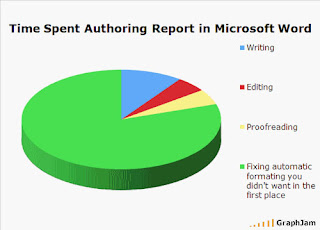Don’t you just love computer programs that profess to know what you want to do better than you do? Neither do I. Okay, I’ll say it. I have a love-hate relationship with Microsoft Word.
When I’m writing I don’t want my word processing application to do things for me. Don’t assume that because I typed a hyphen at the beginning of a line that I want to start a bulleted list, or that I want change the style of an entire block of text just because I increase the font size and make a word bold. And just how does the “ribbon” make it easier for me to see all of the options when I can no longer hover over a menu bar and see the drop-down lists? Just because you can make it look cool doesn’t mean you should.
On the other side of this equation are the things that it should do but doesn’t. I would expect a program smart enough to analyze a sentence and warn you that it is written in passive voice, could figure out that you meant to say ‘does not’ instead of ‘doe snot’. Both pass spell check but couldn’t you warn me (when I ask to be warned) that something seems out of place. Evidently context is not king but someone who visits at inconvenient times. Honestly, when was the last time you read a computer programming book that mentioned the mucus discharge of friendly forest creatures.
When reviewing the galley proofs for my last computer book, I noticed a ‘doe snot’ in the text. Guessing it was not a solitary incident, I searched all of the chapters and found at least a dozen occurrences. Something must have been sneezing over my shoulder.
The root cause of this error is the most common typing mistake, a transposition.
I’m going to date myself now. The very first word processor I ever used was not a program but a dedicated word processing computer called a DECmate with dual 8″ floppy disks. And yes, they really were flexible and “floppy”. It was a joy to use because it did one thing and did it very well.
The case in point is that someone did their homework, and had a way to deal with transposition typos. There was a dedicated key labeled “Swap”. Place the cursor between the transposed characters, hit the swap button, and it … well it swapped them. No more typo. One keystroke, not the three (delete, advance the cursor, retype the character just deleted) that are needed in all modern word processing programs.
We are not repeating history, we are ignoring its positive lessons. Hello? Microsoft? Are you listening? I know you didn’t ask me, but could you please give us a way to easily turn off the stuff we don’t want, and add something we can all use every day like “Swap”?


